Movie Review – Who Framed Roger Rabbit?
Roger Rabbit remains a cinematic triumph, a testament to the skill and craftsmanship of artisans throughout Hollywood, working for years on a project that had never been given a legitimate chance, and at one stage was moments from being canned as the costs of making it began to sprial out of control. Zemeckis, and the team behind him, managed to craft a decidedly enjoyable story and film from a zany idea, a whacky idea that ballooned into one of the top grossing films of it’s year, and a childrens favourite ever since.
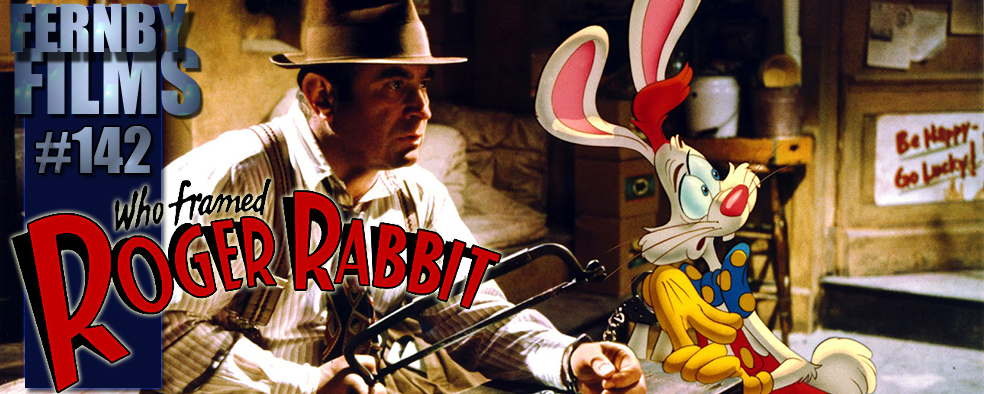
– Summary –
Director : Robert Zemeckis
Year Of Release : 1988
Principal Cast : Bob Hoskins, Charles Fleischer, Christopher Lloyd, Kathleen Turner, Joanna Cassidy, Alan Tilvern, Stubby Kaye, Lou Hirsch, David Lander.
Approx Running Time : 104 Minutes
Synopsis: A beat-down private detective works a case involving a murdered cartoon character, where the prime suspect is another cartoon character.
What we think : Dazzling animated film works wonders even today – it will enchant young tots and frighten older kids, but remain among the most precious of memories for the first-time viewer. Featuing a legitimate all-star animated cast of character (from both Disney and Warner Bros), Roger Rabbit is a work of true genius and invention.
**********************
Dazzling, inventive, and utterly captivating film from director Robert Zemeckis, utilizing a combination of live-action and animation to defy the laws of cinema and create one of most celebrated movie events in modern times. Who Framed Roger Rabbit was the recipient of a special Oscar for animation, as well as being nominated for several more. Almost able to be described as revolutionary, this film changed the way people saw cinema as a storytelling device, with it’s technical skill and engaging screenplay allowing audiences to experience something they’d not seen done so well in the entire history of cinema: the interaction between live-action and animation in real time, on screen.
Unlike other famous examples of this style of film-making, such as Disney’s Song Of The South, in which the animated characters flitted about in a live action world, in Roger Rabbit they actually interacted, existed, within the real world to the point where things moved when they touched them. Combining the cartoon stars of both major studio’s involved with animation in it’s heydey, Warner Brothers and Disney, was a stroke of genius, as it allowed for a broader palette of characters to interact with Eddie Valiant (Bob Hoskins) as he tries to figure out who is setting Roger Rabbit up for murder. Roger, voiced by Charles Fleischer, is an animated rabbit struck from a similar mold as Bugs Bunny, only without the insolent attitude and delectation of carrots. His wife, the amazingly buxom and utterly captivating Jessica, is a humanoid animation of both large boobs and ultra-thin waist, almost akin to a Barbie doll. Jessica, voiced by Kathleen Turner, is the catalyst for the film’s events: she’s caught cheating on Roger (apparently) by Eddie, who is being paid by local cartoon boss R K Maroon, in some sort of leverage deal with the rabbit. Not all is as it seems, however, in this world, as the film is set almost entirely in Hollywood, the back lot of a studio and the interior of a local bar frequented by Eddie on his time off.
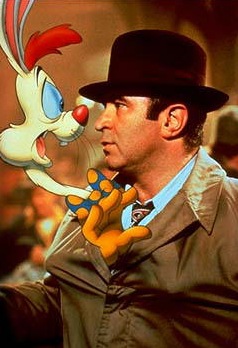
Roger Rabbit is set in the 1947, at a time of great change in America, and in Hollywood. The halcyon days of the Studio System were coming to an end, (they would cease completely in the early 50’s) and the world was breathing a sigh of relief after the end of WWII. Maroon Cartoons (an analogous entity of Warner Brothers’ Looney Tunes) is the leading studio of the day for producing animated films, in much of a mold as the early Bug’s Bunny cartoons, and Roger Rabbit is their leading star. However, his apparent murder of Marvin Acme, the owner of ACME products (you know, they make the anvils that keep dropping on Wile E Coyote when he’s chasing the Road Runner!) leaves a bitter taste in the mouth of Eddie Valiant, a local detective caught up in the story due to his past experience working with the unpredictable, uncontrollable Toons. Eddie’s brother was killed by a Toon on an earlier case, leading to Valiant becoming an alcoholic, bitter old man, so preoccupied with his next drink he is slowly alienating those who care about him. Delores, the waitress at the bar Eddie frequents, has some kind of history with Eddie (it’s never fully explained in the film) and Hoskins’ chemistry with actress Joanna Cassidy is fun and genuine.
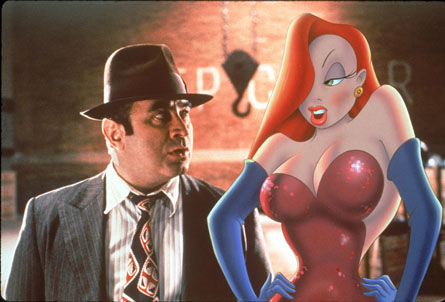
Roger, however, convinces Eddie to help him solve the puzzling murder, since Roger seems incapable of the act himself, and together, they slowly unravel a seedy trail of lies and deception until the truth is revealed; a truth that threatens to destroy Toontown totally, with thanks to the mysterious and creepy Judge Doom (Christopher Lloyd). Doom, sent to capture Roger for the murder of Acme, and accompanied by a gaggle of gangster-esque weasels for henchmen, has his own agenda, and as the film progresses this brings him into sharp conflict with both Valiant and Roger.
Based upon the original book by Gary Wolfe, Roger Rabbit is a massive effort from a horde of filmmakers, most of whom didn’t know if they could pull off what was, until that point, and almost impossible task. Realistically integrating animation into live-action was always going to be a challenge, and Zemeckis, coupled with the producer talent of Spielberg, were up for it. Zemeckis has famously quoted this filming process as his “Invisible Man” picture, since the majority of the live action filming was spent with the actors performing with non-existent characters, leaving vast gaps in the screen, to be filled in later by the animators.
Mention must surely be made of Bob Hoskins’ performance, acting virtually the entire film with nobody to bounce off, almost every scene he’s in involves Roger or some other animated character. Hoskins’ ability to give a believable, realistic portrayal of a man interacting with animated characters is superb; his eyelines perfectly match where the characters should be on the screen at all times, which, if you’ve ever tried acting to nothing, you’ll understand is a difficult thing to do for even the shortest period of time.
To say Zemeckis and his team of artisans pull off the central conceit of Roger Rabbit is to understate just how difficult a process this must have been. To ensure that the effect of an animated creature in a live-action frame works well, everything the animated creature touches and interacts with must move and interact back, which means that plenty of animatronic props and wirework must happen to ensure things move in the right direction. Such attention to detail ensured that when it came time to animate the film, it would look perfect.
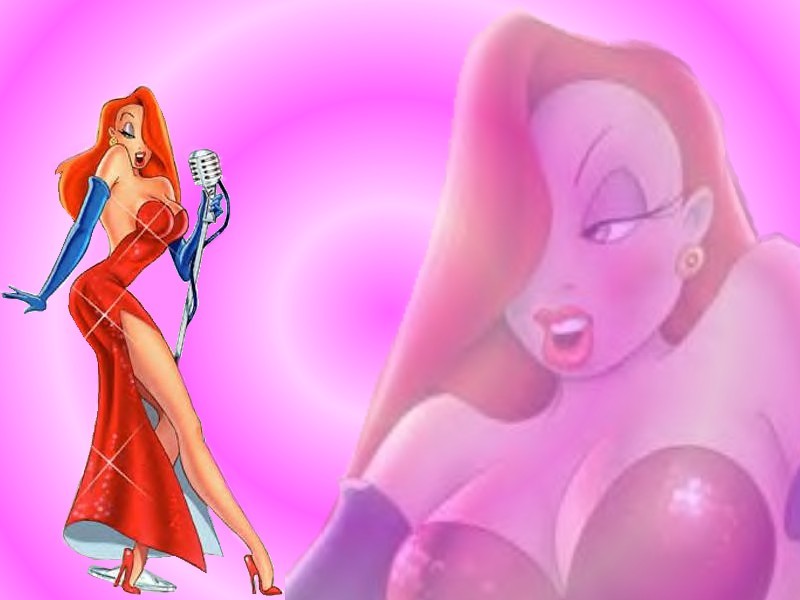
Leaving aside the technical trickery of the film for a moment, we simply must pay respects to the on-screen talent, and their performances. We’ve already mentioned Hoskins, and he’s superb. Joanna Cassidy adds a touch of class to the male dominated cast in her role as Eddie’s romantic interest Dolores. Chris Lloyd obviously enjoyed playing the bad guy here, his Judge Doom is a ferocious, off-kilter villain with little qualms about killing off Toons. Lloyd, a Zemeckis regular from Back To The Future, deals with the terrific makeup effects and scatter-shot personality of Doom with ease, and his gangly slapstick menace is truly terrifying.
But it’s the animated characters that make the film truly shine, with Roger Rabbit and his wife, the delectable and occasionally vampish Jessica being brought to life by Charles Fleischer and Kathleen Turner respectively. Their vocal performances really add to the film, Turner especially, as the vixen who steals Rogers heart and crystallizes the narrative with her iconic performance at the Ink And Paint Club, where even the real-live men of town whistle and stomp their feet as she warbles out her sexually suggestive number. Jessica Rabbit is, apparently, what men look for in an animated woman: buxom (to an almost inordinate degree), sultry, sexy and with a figure to kill for, Jessica Rabbit is one of cinema’s enduring sex symbols. How she landed a husband like Roger is a running joke of the film, and while Roger eschews the more dystopian nature of their physicality, Jessica is more than a match for the ersatz cartoon rabbit. Roger, a frenetic and frenzied cartoon character in the mold of a paranoid Bugs Bunny laced with amphetamines, is a unique creation, a conglomerate of characters imbued within his small frame. Roger, as a character, lacks the subtle comedy stylings of either Bugs or Mickey Mouse, or even similarly personalitied creations like Donald or Daffy Duck, but he’s still a riot at times, if without the feel of those classic characters. Indeed, when Bugs, Mickey, Donald and Daffy, along with almost all the known cartoon characters of the 40’s, appear, there’s a sense of something special going on here.
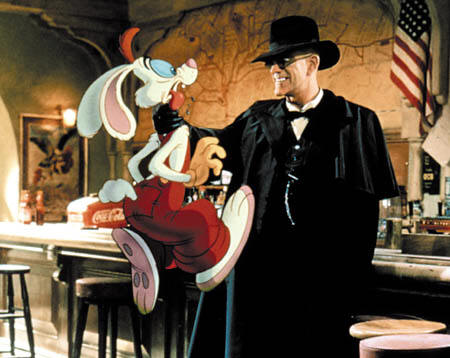
Mel Blanc voices his usual cast of characters, all glimpsed throughout the film, cameos and more beefy parts, although, for the main, the more famous characters of Warners and Disney are relegated to mere bit-parts. Apparently, Disney & Warner reached some sort of agreement ensuring that their copyright characters received equal air time, and in the case of Bug’s and Mickey, they had to receive equal dialogue time as well. This is hardly noticeable, as every time you see Bugs or Mickey or Goofy or Daffy or Porky on screen, it will make any animation fan smile.
One of the main things I loved about Roger Rabbit is the use of the older, less known versions of our favorite characters. Bugs Bunny, for example, is presented here as a more angular, less rotund version than the one we know from the syndicated shorts we all grew up with. Mickey looks less developed, more sketched, than his corporate image dominating the Disney Burbank studios these days. It’s the attention to detail, the use of the 40’s versions of our favorite characters, that’s inspiring here. Kudos to Zemeckis for this.
Who Framed Roger Rabbit has been criticized for it’s somewhat darker tone than most animated films would allow. The presence of Judge Doom, who even gets flattened by a steamroller in a particularly graphic scene (the impact of which is somewhat lessened by the immediate aftermath, where Doom inflates himself with oxygen from a gas cylinder) indicates a more adult tone, for sure, but the kiddies will still eat this up, as the pretty colors and funny characters all fly across the screen. I would agree to a certain extent that the tone of the film is pretty dark, disturbing almost in some moments (especially in the final battle with Doom) but there’s still a sense of fun about the whole show, a sort of cinematic joy that permeates the screen regardless of the overall feeling of foreboding.
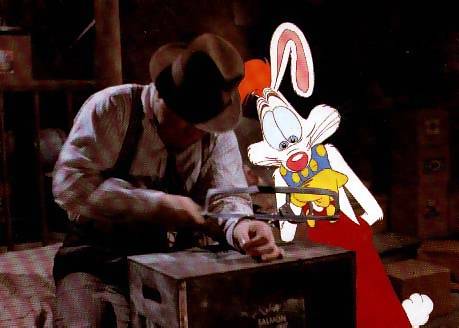
Roger Rabbit remains a cinematic triumph, a testament to the skill and craftsmanship of artisans throughout Hollywood, working for years on a project that had never been given a legitimate chance, and at one stage was moments from being canned as the costs of making it began to spiral out of control. Zemeckis, and the team behind him, managed to craft a decidedly enjoyable story and film from a zany idea, a wacky idea that ballooned into one of the top grossing films of it’s year, and a children’s favorite ever since.
Roger Rabbit is a top class family film, and a well made film in itself, regardless of feelings towards the favorite characters portrayed within it. Superb.



 Who Framed Roger Rabbit: The First Jessica
Who Framed Roger Rabbit: The First Jessica





